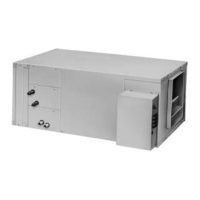SS-APG010C-EN
3
Overview
With R-410A refrigerant and POE oil, this pressure drop can be as high as 50 psid. Within these
guidelines, refrigeration operation is maintained while minimizing the refrigerant charge. It is
still required to limit the liquid line velocity to 600 ft/min to help avoid issues with water hammer.
The liquid line sizes in the component section of this guide reflect these rules.
Suction Lines
R-410A is a high-pressure refrigerant and allows higher-pressure drops in the suction lines. With
R-22, a 2°F loss in the suction line means a pressure drop of 3 psi. With R-410A refrigerant, that
same 2°F loss is a 5 psi drop. Additional pressure drop may be tolerated in certain applications.
R-410A refrigerant suction lines must be sized to maintain oil-entrainment velocities in both the
horizontal and vertical risers. Oil entrainment for R-410A is based on suction temperature as well
as tube diameter. At the time of this writing, no known direct oil-entrainment tests have been
conducted. Trane has used ASHRAE data to create equation-based formulas to predict the
entrainment velocities of R-410A refrigerant and POE oil. These minimum velocities are reflected
in the line sizes listed in the component selection summary (Table 3, p. 16).
Equipment Placement
Minimize Distance Between Components
For a split air conditioning system to perform as reliably and inexpensively as possible, the
refrigerant charge must be kept to a minimum. To help accomplish this design goal:
• Site the outdoor unit (cooling-only condensing unit or heat pump) as close to the indoor unit
as possible.
• Route each interconnecting refrigerant line by the shor
test and most direct path so that line
lengths and riser heights are no longer than absolutely necessary.
• Use only horizontal and vertical piping configurations.
Interconnecting lines of 150 lineal feet (45.7m) or less do no
t
require Trane review, but be sure to
limit the length in risers.
Be sure to review the required accessories for long lengths.
Allowable Elevation Difference
An acceptable riser height represents the summation of all individual risers and is a function of the
total line length.
Outdoor unit above indoor unit. In this case, the velocity of the refrigerant must be sufficient
to force oil up the gas riser in order to maintain proper oil movement during cooling operation. The
gross height and line length for a heat pump in the heating mode must not cause a pressure drop
sufficient to cause excess loss of subcooling. Figure 2 and Figure 3 show the allowable gross rise
and run for TTA and TWA units, respectively. System designs outside the application envelopes
defined in the charts require Trane review.
Outdoor unit below indoor unit. In this case, the pressure drop and accompanying loss of
subcooling due to the total liquid-line length and lift limits the allowable gross lift. The velocity of
the refrigerant gas for a heat pump in the heating mode must be sufficient to force oil up the hot
gas riser in order to maintain proper oil movement. Figure 4 shows the allowable gross “rise and
run” for TTA and TWA units. System designs outside the application envelope defined in the chart
require Trane review.

